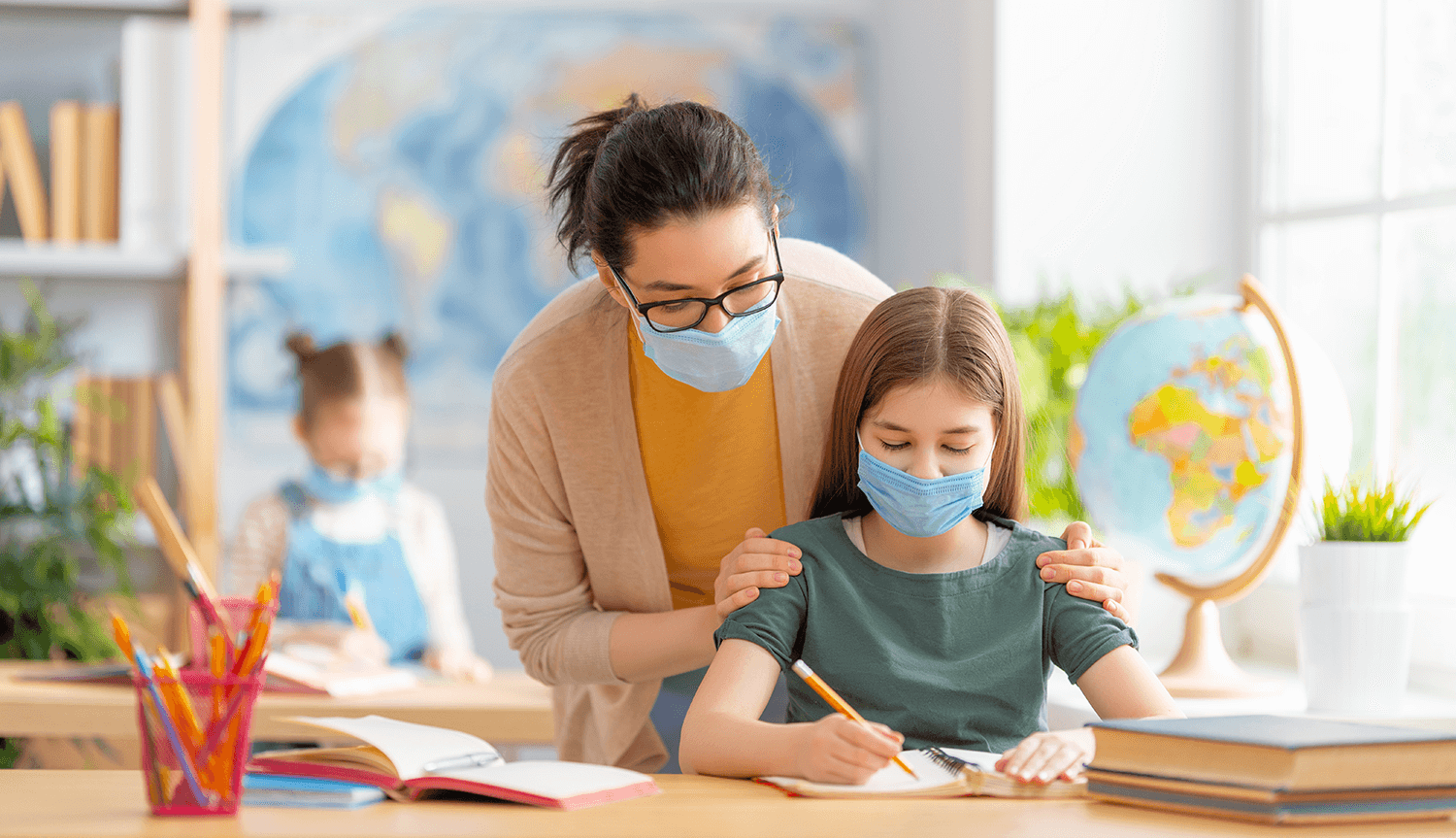9/13/21—At the start of the pandemic, teachers faced a unique situation of transitioning to online learning. This presented numerous challenges, including adequate one-on-one instruction, ensuring proper attendance, and redesigning education plans to fit this new platform. This transition alone left teachers feeling higher levels of stress and lower levels of morale.1 However, now teachers are faced with new dilemmas effecting their mental and physical wellbeing, along with that of their peers and students.
A major cause for concern is the spread of COVID among staff and children. In March 2021, the Biden Administration made education staff a priority to receive vaccinations, which resulted in 80% of all U.S. education staff grades K-12 getting vaccines, according to the Centers for Disease Control and Prevention.2 However, the 20% of unvaccinated education staff and the children under that age of 12 who are not yet approved for vaccines remain at risk. Adding to that risk is the fact that children over 12 have been approved for vaccination, yet aren’t getting them in large enough numbers. According to the CDC, 30% of children aged 12 to 15 have been fully vaccinated, while 40% have received vaccines in the 16 to 17 age group.1 What these numbers mean is that transmission in schools could be high, especially considering that even vaccinated teachers can contract and spread COVID-19.
Compounding the scare of COVID spread is the polarizing debate of mask mandates in schools. Over the summer and into the fall this continues to be a major issue. Currently 16 states have mask mandates, with 25 states having no mask mandate allowing individual counties to make this decision, and nine states banning mask mandates, though three of those nine states have had their bans overturned, allowing for counties to do as they see fit.3 According to CDC guidelines, masks can help slow transmission4, so the issue with certain counties and whole states electing not to mandate masks may create more stress to teachers, as they fear for their health and that of their students.
While physical health is a major area of concern, mental health of education staff took a significant hit over the last year. As teachers dealt with the challenges of remote learning, longer hours in response, and fears for their own well-being, their mental health declined. According to a study by the RAND Corporation, job-related stressors caused by pandemic conditions lead to higher stress levels, depressive symptoms and burnout. The same study found a higher proportion of teachers reporting symptoms of depression than the general adult population. It’s not hard to see that mentally, teachers have faced unprecedented challenges which have taken their toll, even causing as much as one in four teachers to state they would likely leave their jobs by the end of the 2020–2021 school year.5
Though recent studies paint a bleak picture, there are emerging resources available to help alleviate some of the stress, as well as help children and teachers get back to a more streamlined and safe learning environment. In March 2021, the Biden Administration announced the American Rescue Plan, a monetary relief program designed to help Americans struggling during the COVID-19 pandemic. Shortly after, it was announced by the U.S. Education Department that $122 billion of those funds would go towards helping schools reopen. These funds can be used in numerous ways, including providing safer learning environments with better ventilation, personal protective equipment (PPE), installing contact tracing programs like AlertTrace in schools, avoiding layoffs, hiring more staff, and providing mental health resources for staff and students.6
While funding is being made more readily available, teachers can take precautions themselves to further stay safe and protect their students. The best preventative methods, as recommended by the CDC, continue to be maintaining social distancing, wearing masks whenever indoors, practicing proper hygiene by washing hands regularly, keeping hand sanitizer available to staff and students, and getting vaccinated. With this multi-layered approach, teachers can help lessen their risk of contracting or spreading COVID-19.
Through proactive measures, and open discussion between administration and teachers, schools create a better chance of success for opening and staying open. School boards and administrators should be proactive in ensuring their education staff is provided the support and supplies needed to maintain a healthy mental and physical wellbeing. Part of protecting your school includes prevention, and a key to prevention is contact tracing. With AlertTrace’s easy-to-implement contact tracing program, school authorities, staff and parents, can rest assured that any COVID cases are handled diligently and spread is stopped as quickly as possible, while privacy is maintained.
…
1Will, M. (2021, September 2). ‘Here we Are AGAIN:’ WEARY TEACHERS brace for Another Covid school year. Education Week. Retrieved September 13, 2021, from https://www.edweek.org/teaching-learning/here-we-are-again-weary-teachers-brace-for-another-covid-school-year/2021/08.
2Centers for Disease Control and Prevention. (2021, April 6). Nearly 80 percent of teachers, school staff, and childcare workers receive at least one shot of COVID-19 vaccine. Centers for Disease Control and Prevention. Retrieved September 13, 2021, from https://www.cdc.gov/media/releases/2021/s0406-teachers-staff-vaccine.html.
3Burbio. (n.d.). Retrieved from https://about.burbio.com/school-mask-policies-by-state/.
4Centers for Disease Control and Prevention. (n.d.). How to protect yourself & others. Centers for Disease Control and Prevention. Retrieved September 13, 2021, from https://www.cdc.gov/coronavirus/2019-ncov/prevent-getting-sick/prevention.html.
5Steiner, E. D., & Woo, A. (2021, June 15). Job-related stress threatens the teacher supply. RAND Corporation. Retrieved September 13, 2021, from https://www.rand.org/pubs/research_reports/RRA1108-1.html.
6Department of Education Announces AMERICAN rescue PLAN funds for all 50 States, Puerto Rico, and the District of Columbia to help SCHOOLS REOPEN. Department of Education Announces American Rescue Plan Funds for All 50 States, Puerto Rico, and the District of Columbia to Help Schools Reopen | U.S. Department of Education. (2021, March 17). Retrieved September 13, 2021, from https://www.ed.gov/news/press-releases/department-education-announces-american-rescue-plan-funds-all-50-states-puerto-rico-and-district-columbia-help-schools-reopen.




